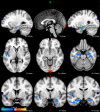Anterior hippocampal dysconnectivity in posttraumatic stress disorder: a dimensional and multimodal approach
- PMID: 28244983
- PMCID: PMC5545643
- DOI: 10.1038/tp.2017.12
Anterior hippocampal dysconnectivity in posttraumatic stress disorder: a dimensional and multimodal approach
Abstract
The anterior hippocampus (aHPC) has a central role in the regulation of anxiety-related behavior, stress response, emotional memory and fear. However, little is known about the presence and extent of aHPC abnormalities in posttraumatic stress disorder (PTSD). In this study, we used a multimodal approach, along with graph-based measures of global brain connectivity (GBC) termed functional GBC with global signal regression (f-GBCr) and diffusion GBC (d-GBC), in combat-exposed US Veterans with and without PTSD. Seed-based aHPC anatomical connectivity analyses were also performed. A whole-brain voxel-wise data-driven investigation revealed a significant association between elevated PTSD symptoms and reduced medial temporal f-GBCr, particularly in the aHPC. Similarly, aHPC d-GBC negatively correlated with PTSD severity. Both functional and anatomical aHPC dysconnectivity measures remained significant after controlling for hippocampal volume, age, gender, intelligence, education, combat severity, depression, anxiety, medication status, traumatic brain injury and alcohol/substance comorbidities. Depression-like PTSD dimensions were associated with reduced connectivity in the ventromedial and dorsolateral prefrontal cortex. In contrast, hyperarousal symptoms were positively correlated with ventromedial and dorsolateral prefrontal connectivity. We believe the findings provide first evidence of functional and anatomical dysconnectivity in the aHPC of veterans with high PTSD symptomatology. The data support the putative utility of aHPC connectivity as a measure of overall PTSD severity. Moreover, prefrontal global connectivity may be of clinical value as a brain biomarker to potentially distinguish between PTSD subgroups.
Conflict of interest statement
CGA has served as consultant and/or on advisory boards for Genentech and Janssen. JHK is a consultant for AbbVie, Amgen, Astellas Pharma Global Development, AstraZeneca Pharmaceuticals, Biomedisyn Corporation, Bristol-Myers Squibb, Eli Lilly and Company, Euthymics Bioscience, Neurovance, FORUM Pharmaceuticals, Janssen Research & Development, Lundbeck Research USA, Novartis Pharma AG, Otsuka America Pharmaceutical, Sage Therapeutics, Sunovion Pharmaceuticals and Takeda Industries; is on the Scientific Advisory Board for Lohocla Research Corporation, Mnemosyne Pharmaceuticals, Naurex and Pfizer; is a stockholder in Biohaven Medical Sciences; holds stock options in Mnemosyne Pharmaceuticals; holds patents for Dopamine and Noradrenergic Reuptake Inhibitors in Treatment of Schizophrenia, US Patent No. 5,447,948 (issued 5 September 1995), and Glutamate Modulating Agents in the Treatment of Mental Disorders, US Patent No. 8778979 (issued 15 July 2014); and filed a patent for Intranasal Administration of Ketamine to Treat Depression, US Application No. 14/197767 (filed on 5 March 2014); US application or Patent Cooperation Treaty international application No. 14/306382 (filed on 17 June 2014). The remaining authors declare no conflict of interest.
Figures



Similar articles
-
Default mode network abnormalities in posttraumatic stress disorder: A novel network-restricted topology approach.Neuroimage. 2018 Aug 1;176:489-498. doi: 10.1016/j.neuroimage.2018.05.005. Epub 2018 May 3. Neuroimage. 2018. PMID: 29730491 Free PMC article.
-
Deficient fear extinction memory in posttraumatic stress disorder.Neurobiol Learn Mem. 2016 Dec;136:116-126. doi: 10.1016/j.nlm.2016.09.016. Epub 2016 Sep 26. Neurobiol Learn Mem. 2016. PMID: 27686278
-
Regional Prefrontal Resting-State Functional Connectivity in Posttraumatic Stress Disorder.Biol Psychiatry Cogn Neurosci Neuroimaging. 2019 Apr;4(4):390-398. doi: 10.1016/j.bpsc.2018.09.012. Epub 2018 Oct 4. Biol Psychiatry Cogn Neurosci Neuroimaging. 2019. PMID: 30449518 Free PMC article.
-
Amygdala, medial prefrontal cortex, and hippocampal function in PTSD.Ann N Y Acad Sci. 2006 Jul;1071:67-79. doi: 10.1196/annals.1364.007. Ann N Y Acad Sci. 2006. PMID: 16891563 Review.
-
Is posttraumatic stress disorder a stress-induced fear circuitry disorder?J Trauma Stress. 2009 Oct;22(5):409-15. doi: 10.1002/jts.20442. Epub 2009 Sep 9. J Trauma Stress. 2009. PMID: 19743481 Review.
Cited by
-
The Neurobiology and Pharmacotherapy of Posttraumatic Stress Disorder.Annu Rev Pharmacol Toxicol. 2019 Jan 6;59:171-189. doi: 10.1146/annurev-pharmtox-010818-021701. Epub 2018 Sep 14. Annu Rev Pharmacol Toxicol. 2019. PMID: 30216745 Free PMC article. Review.
-
Different patterns of functional and structural alterations of hippocampal sub-regions in subcortical vascular mild cognitive impairment with and without depression symptoms.Brain Imaging Behav. 2021 Jun;15(3):1211-1221. doi: 10.1007/s11682-020-00321-7. Brain Imaging Behav. 2021. PMID: 32700254
-
Altered White Matter Diffusivity of the Cingulum Angular Bundle in Posttraumatic Stress Disorder.Mol Neuropsychiatry. 2018 Oct;4(2):75-82. doi: 10.1159/000490464. Epub 2018 Jul 19. Mol Neuropsychiatry. 2018. PMID: 30397595 Free PMC article.
-
Intrinsic Connectivity Networks of Glutamate-Mediated Antidepressant Response: A Neuroimaging Review.Front Psychiatry. 2022 May 26;13:864902. doi: 10.3389/fpsyt.2022.864902. eCollection 2022. Front Psychiatry. 2022. PMID: 35722550 Free PMC article. Review.
-
Autobiographical recall of a stressful negative event in veterans with PTSD.Memory. 2021 Jul;29(6):719-728. doi: 10.1080/09658211.2021.1940204. Epub 2021 Jun 21. Memory. 2021. PMID: 34148527 Free PMC article.
References
-
- Bullmore E, Sporns O. Complex brain networks: graph theoretical analysis of structural and functional systems. Nat Rev Neurosci 2009; 10: 186–198. - PubMed
-
- Koch SB, van Zuiden M, Nawijn L, Frijling JL, Veltman DJ, Olff M. Aberrant Resting-state brain activity in posttraumatic stress disorder: a meta-analysis and systematic review. Depress Anxiety 2016; 33: 592–605. - PubMed
Publication types
MeSH terms
Grants and funding
LinkOut - more resources
Full Text Sources
Other Literature Sources
Medical

